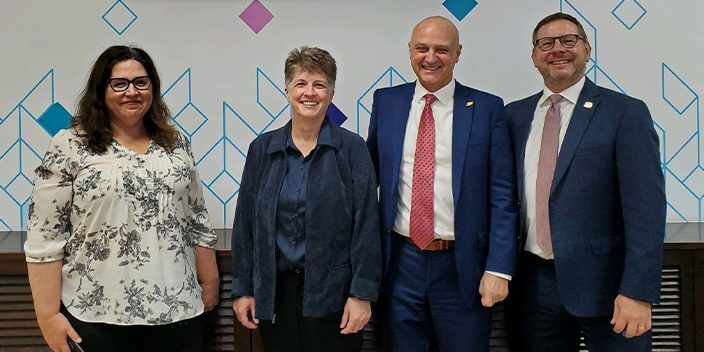The Center for Education and Research in Information Assurance and Security (CERIAS)
The Center for Education and Research inInformation Assurance and Security (CERIAS)

WEST LAFAYETTE, Ind. — An exploding global demand for cybersecurity practitioners has given rise to career opportunities with an assist from Purdue University.
As of Jan. 18, more than 600 potential students have applied for 50 available spots in the U.S.-Jordan Cybersecurity Youth Academy, which officially opened its doors in Amman, Jordan, in November.
The academy is a joint effort of the Global Development and Innovation (GDI) division of the Purdue Applied Research Institute (PARI) and Purdue’s Center for Research and Education in Information Assurance and Security (CERIAS) in partnership with the Princess Sumaya University for Technology of Amman.
“We are extremely pleased to be collaborating with the U.S. Embassy Amman and Princess Sumaya University to offer this important program in cybersecurity to Jordanian youth, especially those outside of Amman,” said John Glover, executive director of PARI’s GDI division. “Given the high demand for these skills, PARI and CERIAS hope to engage the business community to support further programs and to extend the course to other countries.”
The initiative seeks to educate 50 Jordanians, ages 18-24, in cybersecurity, to increase their awareness and, ideally, lead to careers in the field. Both virtual and hands-on training will foster innovation, teach technical skills and offer internships and mentors to students.
The U.S. Embassy in Amman supports the academy, and PARI and Purdue endeavors are funded with a U.S. Department of State grant. Virtual classes are to start this spring, and in-person classes begin in August.
The opportunity — the creation of the U.S. Embassy in Amman, which with the State Department sought organizations to develop and administer the academy — is a natural fit for PARI and Purdue, said Joel Rasmus, CERIAS managing director, and Margaret McDonough, GDI’s director of practice.
“Purdue has long been committed to cooperation with Jordan,” Rasmus said.
CERIAS has been part of university-based programming in Jordan through the U.S.-Jordanian University Cooperation Network, where Rasmus has led the cyber studies track. Through that association, Purdue could develop relationships with many counterpart organizations and cyber faculty members in the case of Jordan.
“From the embassy’s point of view, they designed the program in direct response to feedback they got from cyber-sector leaders in Jordan, which was that we had to start a lot earlier getting kids engaged with cybersecurity in several ways,” Rasmus said, including basic cyber hygiene, awareness and responses to cyberbullying and identifying scams. The embassy also wanted to introduce Jordanian youth to career pathways, giving them exposure and experience in the cyber fields that may entice them into careers.
This work, however, is a broader story than Jordan, McDonough said.
“This is built on an established track record of impactful contributions in global development work,” she said. “GDI’s mission is to bring Purdue research and learning capabilities into global development, and the Jordan cyber academy is a good example of that. This builds on some of the work Purdue has done around the world for years.”
What PARI and Purdue had to offer aligned with what the Kingdom of Jordan and Princess Sumaya University for Technology hoped to achieve, and the State Department wanted to provide. Purdue offered a curriculum layout that “delivered everything the embassy was looking for,” Rasmus said.
The academy holds promise for young adults in Jordan, where social media use has skyrocketed among those 18-35. This demographic holds roughly 6.6 million social media accounts, according to a Google study.
But with this rise in social media use has come a rise in cybercrime. Many of these young Jordanians lack awareness and tools to combat cyberbullying, threats, phishing and the spread of misinformation, Rasmus said. Social media also fomented an increase in scammers and blackmailers who use information from these sites to target potential victims, he said.
Training Jordanian youth also makes them candidates to fill the global demand for cybersecurity professionals. According to State Department data, many such jobs remain unfilled as employers struggle to find workers with the skills and academic backgrounds needed to address cybersecurity challenges.
One thing that excites Rasmus about the cyber academy is the career opportunities it offers a diverse array of people. “In Jordan, as in the rest of the world, people with physical limits can have careers in cybersecurity. Women have done extremely well in this field,” Rasmus said.
McDonough agreed. “Purdue is recognized as a world leader in cybersecurity, but we know we don’t have all the answers,” she said.
This program is designed for iteration in collaboration with Princess Sumaya University for Technology and the Jordanian public and private sectors, she said. “We are not here to push a U.S. agenda; we are here to support locally led initiatives.”
Rasmus is the lead trainer and technical coordinator for the cyber academy. McDonough will provide PARI management and program oversight. Faculty from Purdue, Princess Sumaya University for Technology, and other university and industry representatives will offer instruction. For more information, visit https://www.cerias.purdue.edu/site/jordanyouth.
WRITER/MEDIA CONTACT: Evamarie Socha ecsocha@purdue.edu
SOURCES:
John Glover gloverjr@purdue.edu
Margaret McDonough mmmcdono@purdue.edu
Joel Rasmus jrasmus@purdue.edu